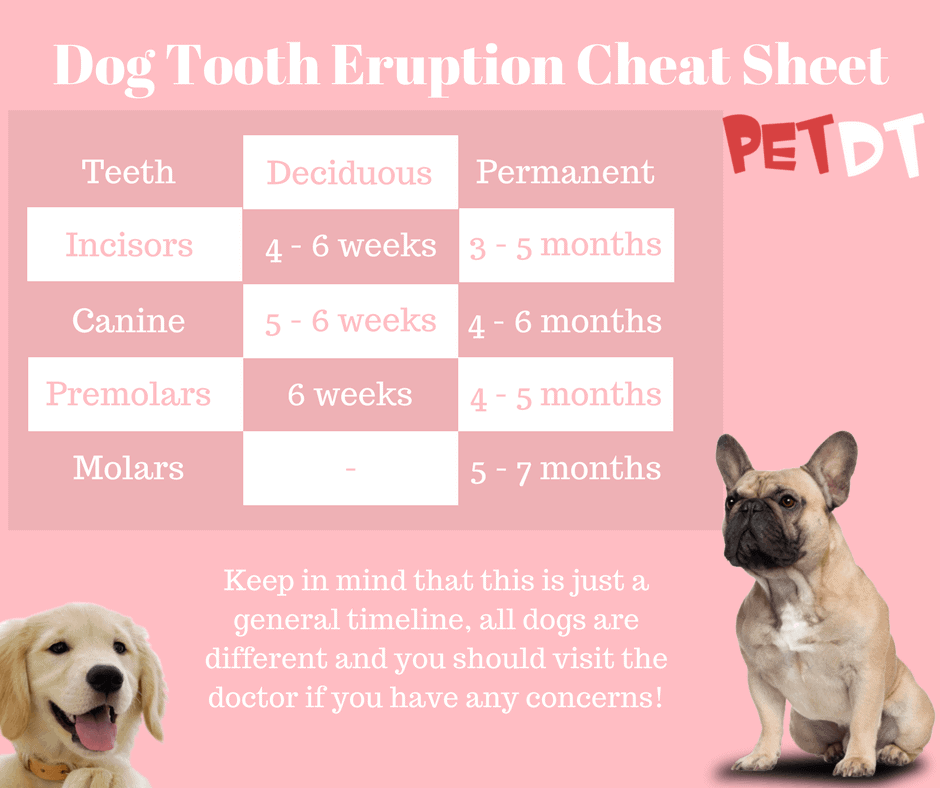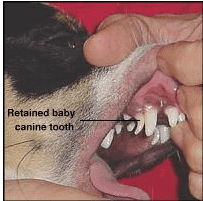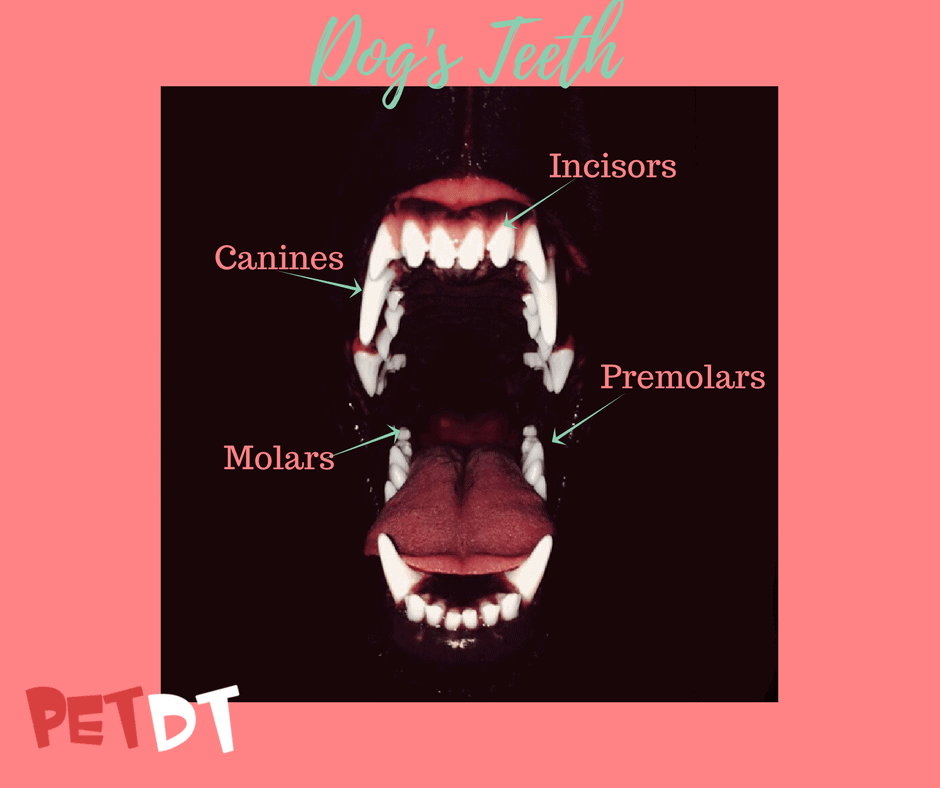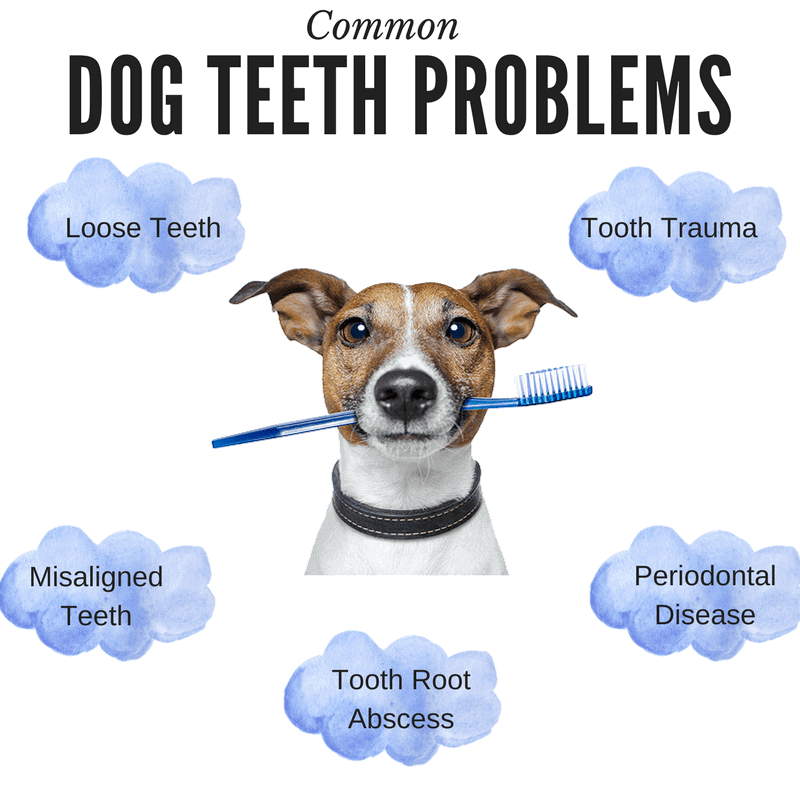Did you know that tooth decay in dogs is a really big problem!?
The thing is that dogs use their teeth for everything—from showing love and affection to eating, holding things, etc. and your dog’s teeth are really important parts of their body.
We, as humans, have hands that we use to do most of our stuff, but, in the case of dogs, they only have their teeth.
So, in this blog post, I’ll be going through your dog’s teeth, how to take care of them, common problems, etc.
Are you ready?
Let’s begin!
Dog Teeth Basics
Did you know that just like humans, dogs, too, have two sets of teeth throughout their lives?
By the age of six weeks, a puppy has 28 teeth in its mouth!
Of course, these 28 teeth do not include molars or premolars since the puppy doesn’t really need to do any grinding in the first few weeks of his life as he sustains mainly on its mother’s milk and other soft food.
So, what happens to these baby teeth?
Well, puppies start shedding these baby teeth by the age of 4 months. Some baby teeth don’t shed and are still in your dog’s mouth.
An adult dog has 42 teeth—but this number of teeth usually depends on the breed of the dog—some large breeds are known to have more teeth.
Teething in Puppies
If you have ever raised a puppy, you know that teething is probably the worst time for your puppy (and your furniture, shoes, socks, etc.)
So, in this section of the article, I’ve decided to talk about teething and how the process of teething takes place.
Let’s get started…
Following is the order in which teaching takes place in puppies:
- Incisors are the first to break
- Canines are next in line
- Premolars come next
- Finally, the molars come in

Teething is an extremely frustrating time for your dog.
So, what should you do?
I recommend that you invest in some of the best chew toys for puppies to save your shoes and furniture from your tiny little ball of fur!
When my puppy was teething, he had torn a few of my books and destroyed my $100 Steve Madden shoes, among other things…
What can you do?
Well, I would recommend two things:
- Train your dog well (I’ve written about the technique here)
- Reroute your dog’s energy onto other things he’s allowed to chew/ put into his mouth.
For rerouting purposes, I recommend that you get your dogs some exciting chew toys like the West Paw Design Ball Chew Toy or the Nylabone Dura Chew Knot.
I have rounded up the best chew toys for puppies so that you can check them out over here.
Let me know in the comments section if it worked for you!
Anatomy of a Dog’s Teeth
In this section of the article, we’ll talk about the anatomy of your dog’s teeth and how evolution played a major role in this.
So, let’s get started!
So, we all know that dogs are carnivores, but we have turned our furry pets into omnivores because their feed contains a lot of plant-based material.
But why did I bring up the carnivore thing?
Well, since that dogs are carnivores, they have teeth that can tear through flesh and support a digestive system that can get nutrients from meat.
Your dog’s teeth aren’t just for eating, though!
They also help show emotions on your dog’s face. For example, if your dog is angry, chances are that he’ll show you his teeth as a warning sign—some dogs also smile by showing off their teeth when they’re happy.
Common Problem with a Dog’s teeth

Ideally, when a puppy is teething, all of its teeth should fall off and be replaced by a new set of
teeth—but that is not usually the case with all dogs as some dogs retain their deciduous teeth.
The baby tooth can hamper the permanent tooth’s growth and can even cause it to grow abnormally.
Your Dog’s Teeth: The Anatomy!
So, as you may already know, your dog’s teeth are divided into four main parts, namely:
- Incisors
- Canines
- Premolars
- Molars
All four of these teeth work together in order to hunt and eat prey!

The Incisors
Small teeth in the front of the mouth, just like humans! These teeth aren’t very sharp.
Your dog has 6 incisors on the top and another 6 on the bottom.
The Canines
These are the scary-looking sharp teeth on the sides of your dog’s mouth. They are used for tearing the food down.
Your dog has two of these on the top and two on the bottom.
The Premolars
The next in line are the premolars and your dog has four of these on the top, and another four on the bottom and these are used to:
- Biting down the food
- Chewing the food into small pieces
The Molars
The molars are used for chewing food and have the most tartar buildup on them.
Your dog has two molars on the bottom of the mouth and two of these on the top.
I hope that this section covered the basics well without it being too technical for you to understand! Let me know in the comments section how you liked it! And if you have any questions, please feel free to ask!
Moving on…
Taking Care of Your Dog’s Teeth: Brushing
Brushing your dog’s teeth is important.
If you are a new dog owner, then brushing your dog’s teeth can be a really stressful task—for you and for your furry friend!
But how else can you fight off plaque and dental issues!?
In this section of the blog, I’ll go through one of my favorite techniques for brushing my dog’s teeth.
Let’s begin!
Get a Dog Toothbrush and Toothpaste
Let’s start by talking about the toothbrush.
I would highly recommend that you get a toothbrush made specifically for your dog because:
- They can easily access the crevices of your dog’s mouth
- The bristles are made to clean a dog’s mouth
But…
In case you do not have a dog toothbrush, you should pick up a child toothbrush instead, as it is better suited for your dog.
For the toothbrushes, I recommend the Wyqu Dog Toothbrush set and the Virbac CET Oral Health Kit.
As for toothpaste, never use human toothpaste for your furry friend!
This is because normal toothpaste contains fluoride and other ingredients that are really toxic for your dog!
On the other hand…
Dog toothpaste is safe for your dog and comes in different flavors, making brushing your dog’s teeth easy.
The toothpaste that my dog loves includes Petrodex Enzymatic Toothpaste Dog Poultry Flavor, and Arm & Hammer Advanced Care Enzymatic Toothpaste for Dogs.
Start When Your Puppy Is Young!
I’ve said the same thing about grinding your dog’s nails.
And this, too, has the same logic as that!
The thing is that when you start brushing your dog’s teeth while he’s still young, he’ll get used to it, and this will make brushing a pleasant as well as a bonding experience for you as well as your dog!
So, start early.
While we’re at it, I would also recommend you to start grinding your dog’s nails early as well.
Introduce The Toothpaste and Toothbrush to Your Dog
Your dog needs to get used to the having the toothpaste and the toothbrush in his mouth in order to get comfortable with the brushing.
So here are the steps you should follow:
- Start by letting your dog taste a tiny amount of the toothpaste
- When your dog licks it off, try to ‘brush’ your dog’s teeth with your fingers to make the transition easier
- Show the toothbrush to your dog with the toothpaste on it, and let him lick the paste
You should always reward and praise your dog in these tiny steps to make the transition to brushing more comfortable.
Start By Brushing a Few Teeth at a Time!
One of the biggest mistakes that dog owners make is straightaway brushing all of the dog’s teeth—making the process traumatic for their dog!
As I have said before, you should take baby steps while brushing your dog’s teeth.
And so, you should start off by brushing the front few teeth of your dog and work your way back gradually over a span of a few days.
Make It or Break It: The Habits
We have one ultimate goal: consistently brushing your dog’s teeth in order to avoid any dental problems.
And so, we should not just brush the dog’s teeth once in a blue moon—that simply won’t work!
Try to brush your dog’s teeth regularly and try to turn it into a routine.
Common Problems in A Dog’s Teeth

Did you know that about 85 percent of dogs over 4 years of age are plagued with gum disease?
And that’s not even all!
There are other problems such as cracked and crooked teeth, loose teeth, an abscess or a tooth infection that cause canines a lot of problems!
And the worst part of it is that you may not even know that your dog is hurting!
Wondering why?
Well, it’s all in the genes.
In the wild, showing signs of pain and discomfort would make a dog vulnerable to getting attacked—and your dog has the same instinct!
So, how do you even determine that your pooch is sick?
There are a few signs that you should look out for, such as:
- Change in eating habits
- Loss of appetite
- Rubbing face against things
- Swelling on the face
In this section of the blog, I’ll explain in detail all of the issues that surround your dog’s teeth.
Did you know that pale gums in dogs can be a sign of internal bleeding?
Read more here.
So, let’s begin!
Loose Teeth
Loose teeth really aren’t a problem for puppies.
This is because all of the teeth in their mouths usually fall off by the time they’re six months old, as I’ve said before in this blog post.
So, for puppies, you needn’t worry too much.
I would recommend that you look into your puppy’s mouth once in a while to see what’s going on.
And don’t worry! Puppies do retain their baby teeth in their mouth; they’re fairly common.
On the other hand…
When two teeth go on to occupy the same spot in your dog’s gum, it is time to go to the vet.
The vet will help you get rid of the extra baby teeth so that the new, permanent teeth aren’t crooked and don’t cause problems in the future.
Loose teeth are a major problem for adult dogs because they are a result of trauma that your dog might have taken to his mouth.
Aside from that…
A loose tooth could also indicate gum loss or advanced periodontal disease, among other illnesses.
I would highly recommend you to visit your vet at the first sign of a loose tooth. Your dog might need an x-ray so that your doctor can determine the cause of the loose tooth. In severe cases, a dental extraction may even be necessary!
Misaligned Teeth
Humans have it, and so do dogs!
It is a fact that some breeds are specifically known for their trademark bites, but when the situation is really severe, misaligned teeth can cause a lot of pain while chewing! And your dog can even end up hurting himself every time he eats.
Misaligned teeth can occur due to extra deciduous teeth in your dog’ mouth, or due to the misalignment of the upper or lower jaw.
With human beings that have misaligned teeth, we usually get them fixed by the orthodontist for that million-dollar smile.
But, obviously, the looks don’t matter for dogs; after all, every dog is beautiful!
In veterinary medicine, misaligned teeth are taken care of only if they:
- Cause pain to the dog
- Prevent the dog from eating food or drinking
If your dog does have a serious problem, the veterinary dentist will have to realign your dog’s teeth.
Now, this doesn’t mean braces!
Tooth extraction, or capping the problem tooth, etc., are some solutions that your vet will offer.
Obviously, it all depends on a lot of factors!
However, there is one more thing.
If the vet determines that the tooth issue is genetic, your dog may be ordered to get spayed or neutered in order to protect dogs and safeguard the generations to come from this disorder.
This, of course, depends on the region that you’re from.
Did you know that does with misaligned teeth are more susceptible to other orthodontic diseases?
Let’s take a look!
Periodontal Disease
Does your dog leave spots of blood behind on his toys after playtime?
Well, your dog’s chew toys carry a lot of clues regarding your dog’s oral health, so you should try to look through them to keep yourself in the loop.
Periodontal diseases begin when the plaque present in your dog’s teeth turns into tartar which is a brownish substance that is known to move under the gum line and cause gingivitis or develop puffy and red gums.
Disgusting, right!?
Well, when we leave gingivitis untreated, it progresses or turns into periodontal disease.
This disease causes the gums to lose their function and recede, which makes tooth loss an eventuality.
Other than that, this disease also introduces infection, which travels into the bloodstream of your dog and causes infection all over.
No matter what the breed, all of the dogs are prone to getting this disease. But, there are a few factors that increase the risk:
- Dog’s age
- Immune system
- Diet
- Chewing habits
- Dental hygiene
So, of course, the best possible way to fight off the periodontal disease is to stick to a good dental care routine. This includes a good brushing routine, good chew toys, and routine dental care check-ups.
You should start this at a very early age so that your little puppy gets used to mouth handling and brushing, etc.
If you see any signs of the disease, contact your veterinary dentist and get your dog checked up as soon as possible.
Also, you can invest in getting your dog’s teeth professionally cleaned.
Tooth Trauma
Dogs love to chew.
But you should try to keep an eye on what your dog chews for chewing the wrong object can wreak havoc on your dog’s teeth and cause him a lot of dental distress!
If that wasn’t all, solid and rigid objects are known to crack or break a tooth. And guess what? Your dog can also break his teeth by playing tugging games, rough play, or through impact injury!
Of course, this doesn’t mean you shouldn’t let your dog have fun!
Slab Fracture is a very common sight that you can see in a dog’s mouth, and it occurs when a dog forcibly bites on a hard thing.
This causes a section of your dog’s tooth to flake off, which can cause a chip or a large gaping fracture.
The problem with cracked or broken teeth is that the nerves become exposed—which in turn, causes a lot of pain to your dog. In some cases, the nerve dies, and the pain ultimately subsides.
But that’s not all!
The broken tooth can get infected, which can eventually result in a lot of pain!
But the good news is that this is totally avoidable.
All you need to do is to keep a strict eye on your dog and take note of the things he chews on—not allowing your friend to chew on anything too hard.
You should definitely avoid the following:
- Hooves
- Brittle bone
- Rocks
- Crate railings
- Solid posts
You get the idea, right?
May sure that the chew toys that you get your dog are flexible and is as hard as a nylon or rubber material.
After all, prevention is always better than cure!
But, in case you do feel that your furry companion has a broken or cracked tooth, check in with your vet immediately—even if your dog isn’t bothered about it.
There are a lot of treatments that can be done—depending upon the amount of damage the tooth has taken.
The popular treatments include:
- Tooth extraction
- Root canal
- Vital pulpotomy
But, as for the treatment goes, always go with what your doctor recommends.
You Might Also Like the following:
Bestpetguides.com have a handy guide if your dog won’t stop chewing his bed.
A broken or fractured tooth can also lead to a tooth abscess. Let’s learn about that, shall we?
Tooth Root Abscess
This is one of the most agonizing dental health problems that your dog may experience.
A Tooth Root Abscess occurs when the root of your dog’s tooth becomes exposed to the harmful bacteria through a crack or a break. It can also be caused due to gum damage as a result of periodontal disease.
There are a few signs that you should look out for:
- Difficulty in eating
- The dog may drop food
- The dog may tip his head to one side while eating
- The dog may avoid eating
- Facial swelling
Sometimes, your dog’s eyes may also look inflamed due to tooth root abscess—this is because of the location of the infected tooth in your dog’s mouth.
When you look inside your dog’s mouth, you should be able to find the infection as the infected tooth may have swelling, a lump, or may even be red.
The abscess can even spread to the surrounding teeth making it difficult to determine which tooth is infected.
If you see any signs of this, make sure to book an appointment with your vet immediately, as it is very painful for your dog.
There are a few things that can be done:
- Root canal treatment
- Tooth extraction
Other than that, your dog will be given antibiotics to combat the infections, and pain medication may also be given to help your dog feel better during the treatment.
Conclusion
We talked an awful lot about your dog’s teeth, didn’t we?
Well, I really hope that I was able to cover all the important topics that I could. If you are looking for more information, please feel free to comment your questions, and I’ll reply to your queries as soon as possible.
A dog’s teeth are really important parts of your furry friend’s anatomy, and they should be taken care of well.
After all, your dog needs them to do a lot of things!
You should make a point to brush your dog’s teeth regularly and take your furry friend to the dog dentist on a regular basis for optimal dental hygiene.
After all, your dog’s teeth will take him a long way!
If you know someone who can benefit from this article, please share it! And let me know your thoughts in the comments section.
